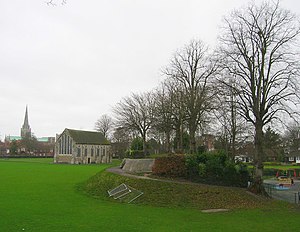Difference between revisions of "Rape of Chichester"
m (→Divisions) |
|||
| Line 25: | Line 25: | ||
*[[Aldwick Hundred|Aldwick]] | *[[Aldwick Hundred|Aldwick]] | ||
*[[Bosham Hundred|Bosham]] | *[[Bosham Hundred|Bosham]] | ||
| − | *[[ | + | *[[Box and Stockbridge]] (including City and Liberty of Chichester) |
| − | *[[ | + | *[[Dumpford]] |
*[[Easebourne Hundred|Easebourne]] | *[[Easebourne Hundred|Easebourne]] | ||
*[[Manhood]] | *[[Manhood]] | ||
| − | *[[ | + | *[[Westbourne and Singleton]] |
==Outside links== | ==Outside links== | ||
Latest revision as of 09:09, 2 March 2021
The Rape of Chichester is one of the rapes of Sussex, the traditional divisions unique to that county. The most westerly of these, Chichester is a former barony, originally centred on Chichester Castle in the city of Chichester.
The rape covers 145,840 acres, the whole north-south depth of Sussex from the Hampshire border to Bognor Regis. It had a population of 153,477 in 2011.
History
The rape is not mentioned independently of 'the rape of Earl Roger' in the Domesday Book[1] and passed by inheritance as a single unit, out of all proportion to the other rapes in size, until the 13th century. First mentioned as the 'Bailiwick (Balliua) of Chichester' in 1264, it first appeared by name as the rape of Chichester in the Hundred Rolls of 1275.[2] It was referred to as the Rape de Cycestre in 1279,[1] le rape de Cicestre[1] in 1376 and of Chichestre in 1495.[1]
One view has it that the rape of Chichester was created out of the larger Rape of Arundel, perhaps a new division connected with the partition of the estates of Hugh d'Aubigny, 5th Earl of Arundel, the last Earl of Arundel of his line, between his co-heirs after his death in 1243. While John FitzAlan acquired Arundel, Robert de Mohaut obtained the overlordship of the twelve fees constituting the honor of Halnaker, and certain other estates in the vicinity. The unity of overlordship being thus lost, it may have appeared convenient to divide this district into two separate rapes, which would be of a similar size and nature to those in the rest of Sussex. No trace of any orders given or measures taken to create the division of the old rape of Arundel has been found.
It is possible however that the rape of Chichester existed before the Norman Conquest. The rapes in general pre-date the Norman Conquest and many rapes are based on King Alfred's fortifications in the Burghal Hidage. As Chichester was also a fortification in the Burghal Hidage, it is quite possible that it existed as a separate administrative unit in the Saxon era and was linked to neighbouring Arundel rape by William the Conqueror and given to Earl Roger of Montgomery. If King William created five rapes only in Sussex, it would seem odd that one, Arundel, would be out of all proportion to the others in size, but the evidence is lacking.[1]
The population of the rape of Chichester was counted as 21,608 in 1801,[3] rising to 24,200 in 1811[3] and 38,929 in 1831.[4]
Location
The most westerly of all the Sussex rapes, the rape of Chichester borders the rape of Arundel to the east, with Hampshire lying to the west and Surrey to the north. The boundary between the Rapes of Chichester and Arundel starts on the coast at the small stream dividing the parish of Pagham from that of Felpham.[2] The boundary runs roughly due north, except for a divagation eastwards to include the parish of Slindon, which was a peculiar of the Archbishop of Canterbury and so was attached to the archbishop's hundred of Pagham.[2] Within this area, the long narrow strip constituting North and South Ambersham was long considered a tithing of the Parish of Steep in Hampshire,[2] though locally situate in Sussex. This was deemed to be part of Sussex by the Counties (Detached Parts) Act 1844.[2]
The Rape of Chichester includes the City of Chichester and the towns of Bognor Regis, Midhurst and Selsey. Its highest point is Blackdown, which at 919 feet is the highest point in all of Sussex.
Divisions
The rape is divided into the following hundreds:
- Aldwick
- Bosham
- Box and Stockbridge (including City and Liberty of Chichester)
- Dumpford
- Easebourne
- Manhood
- Westbourne and Singleton
Outside links
- Chichester Rape - A History of the County of Sussex - Volume : {{{2}}} (Victoria County History)
- Chichester Rape through time - A Vision of Britain
References
- ↑ 1.0 1.1 1.2 1.3 1.4 Mawer, Allen, F. M. Stenton with J. E. B. Gover (1930) [1929]. Sussex - Part I and Part II. English Place-Name Society.
- ↑ 2.0 2.1 2.2 2.3 2.4 The rape of Chichester A History of the County of Sussex - Volume : {{{2}}} (Victoria County History)
- ↑ 3.0 3.1 Dallaway, James (1815). A History of the Western Division of the County of Sussex, Volume 1. T. Bensley.
- ↑ Knight, C (1842). The Penny Cyclopaedia of the Society for the Diffusion of Useful Knowledge, Volumes 23-24. C. Knight.

